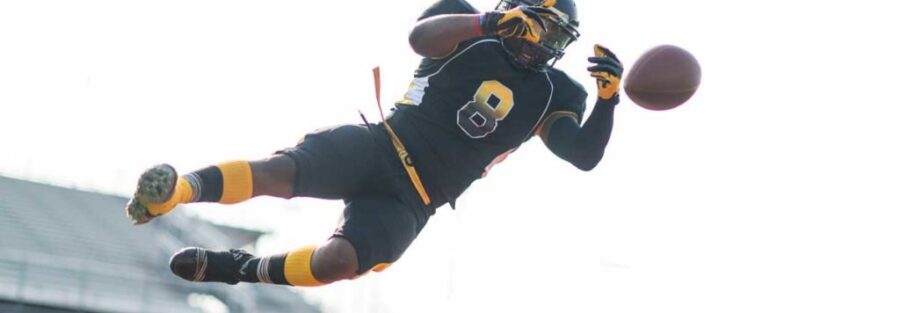Every athlete has different needs and areas they can improve, and using key performance indicators will give you an easy guide for how you need to train your athletes. Here at Varsity House Gym—given the different sports, ages, and ability levels of the athletes who come to us—we have established different KPIs or testing standards that we track for each age group. These allow us to establish where an athlete is and help guide us on what they can improve on going forward.
Working closely with high school football players, many of whom have been with us for some time now, making sure they are still improving requires us to be more detailed in our tracking of their training progress. By establishing a base of qualities to focus on improving—factors I know will transfer on the field—I can then design a program that improves upon those abilities. If my KPIs are accurate and they improve, I can say with confidence that the athlete is getting better as well. But the process does not stop here, you can dive even deeper into selecting performance indicators based off of individual athletes as well.
In this article, we will break down the what, how, and why of using key performance indicators in your performance program.
What is a KPI?
A “Key Performance Indicator” is a concept taken from the field of finance, where it is simply a metric used to decide the effectiveness of a strategy. What does that look like in the context of strength and conditioning? Simple—any combine test can be considered a KPI (but we all know not all combine tests transfer to the sport they are designed for). So our goal here is to find a better way to evaluate what will transfer from the training space to the field of play.
Understand Your Athlete
For strength and conditioning coaches, the starting point is understanding the sport each athlete plays. Here is a list of questions that need to be answered to begin the process of identifying good KPIs for your athletes:
-
- What energy system does the athlete primarily use?
-
- How much recovery time does the athlete get between bouts?
-
- Does the athlete need to change direction? How frequently?
-
- What speeds does the athlete work at? Acceleration? Top speed? If it is a blend, which does the athlete need to improve more?
-
- Does the athlete physically engage with other athletes or objects? Do they need to be more physically dominant? How frequently?
-
- What systems/space do you have at your disposal to test and track efficiently?
Once you’ve answered these questions, you can see what you need to focus on to help your athletes get better. You can start by breaking things down into segments: if your athlete needs to be maximally strong, you may need to implement a performance indicator for maximal strength. Does your athlete change direction constantly, like a tennis player? You may need to look at a lateral shuttle test to track their progress.

Recognizing what your athlete needs in their sport and then selecting a few testable movements to track throughout their training will dramatically improve the focus of your training.
In my time as a strength and conditioning coach, I have worked with many defensive backs in football and have developed my own KPIs that I use to track and test my athletes. Most of the guys I work with are not strangers to hard-work, so guiding them on where to focus to help them improve the most is a big part of what I do. Having KPIs to give them a focus point helps tremendously in guiding their work ethic. Note that these are what work for me with the space and equipment I have to effectively and efficiently track and test my guys. What you use may differ depending on what you are able to facilitate in your space, based on equipment, space, and a range of factors.

How to Integrate and Use your KPIs
Once KPIs are established, we need to use them and apply them to the athletes. No, a pre-test and post-test are not enough to say “We used these KPIs and look at our results.” If you have acknowledged that these things are needed to improve the athlete, they need to be at the forefront of training at all times. This means that we need to be working on improving at least one KPI per training session throughout the week. At Varsity House, we have up to 5 training days for our HS athletes: Upper Lift, Linear Speed, Lower Lift, Change of Direction, and Recovery days to ensure each athlete is touching on each part of their training needs.
My approach is a 3 step process to take each KPI and decide what weight room movement will translate and how to implement that movement. I personally like seeing examples, so I am going to use an example of improving the vertical jump (from the above chart of KPIs) and take you through the process of programming for that KPI.
Step 1: KPI to Main Lift/Movement
The first thing to establish once you have identified your KPIs is what weight room movements will transfer to each KPI. The main thing I would look to mimic here would be the force-vector of the KPI—obviously, with a vertical jump, we would need to apply force in a vertical direction. Deciding what vector your KPI is in and then selecting a main lift or movement that matches that to some extent is a good way to get started on what movements to use.
If the force-vector does not narrow it down enough, from there I would look at the muscular demands of the movement—what muscles are the main movers? A sprint may fall in this category of hard-to-define vectors, so you would identify your main muscular demands. Using the KPI table for defensive backs, a movement I may do to improve vertical jump ability could be a front squat.
After you have identified the main movement, you would identify the muscular demands of that movement and the KPI to help select any supplemental work. Using that knowledge, you need to then identify any weak points your athlete may have within those movements and select a supplemental lift accordingly. For example, if I have an athlete that has weak glutes and struggles getting out of the hole, I may put him with a weighted hip thrust as a supplement to work on that. As you can see, this allows you to personalize the program for each athlete you work with.
Step 2: Force-Velocity Curve
Next, we need to identify where on the force-velocity curve the KPI ranks and how we can stimulate a similar response with our strength movement. Continuing with the example above, we know with a vertical jump that the velocity will be upwards of 1m/s and be on the “speed-strength” end of the spectrum. With that being said, we also know what we need to improve with our strength movement. Ideally this would be done with some form of bar velocity tracker to guide us, even if it is just a phone app.

One thing to note: since I may want to get an athlete to perform at a certain percentage at a certain velocity—again to work backwards—obviously improving absolute ability/strength will also help us get there. But, keeping in mind my KPIs, I may not want to stray too far down that rabbit hole depending on where that athlete falls in their training age. I may want to improve a novice athlete’s absolute strength; contrarily, with an intermediate or advanced athlete, I may want to improve power output instead.
Step 3: Energy Systems & Volume
To recap, we have established what movements we will use and what velocities we need to work at and improve upon. Now, our next step is energy system development—which can be worked on both in the weight room and on the field. Knowing the average length of a play for a defensive back is 7-10 seconds, and that they will get anywhere from 30-45 seconds rest between plays, I have my layout for my reps and rest laid out for me already.
How do we decide volume? Personally, I have had a lot of success using Prilepin’s chart to guide my volume parameters for the main lifts. If you look at the chart, you can estimate that 7-10 seconds of work can be 3-5 reps per set, and I know my percentages from my velocity curve so it is now simple plug and play.
I tend to look at the 70-75% and 75-80% ranges as the main ranges you will be working in for my main lifts. So to add to our example, I may program:
- Front Squat 5×3@75% with 45s Rest
I am hitting my velocity requirements, my percentage requirements, and finally my energy system requirements to help improve the performance indicator and energy system development.
As a bonus, HERE is a chart of metabolic pathways to use to help you decide what may be best for your athletes. By observing the athlete’s sport, you can see how long a bout may be and then time how long their rest is to find out where on the chart they fall.
One thing to note: I am not ignoring the fact that athletes can benefit from different conditioning/metabolic abilities, I am simply focusing on the main metabolic component of a specific sport and/or position. I have found that training in this manner helps athletes improve in the specific metabolic pathway of their sport and position.
Why KPIs?
The number one reason I would suggest using a KPI for your athletes is it allows for you to train specifically for a general adaptation. To use our example from throughout this article, if I know that I want to improve an athlete’s vertical jump because that will transfer on the field, I know what movements and percentages to work at. If I know the energy system my athlete will be playing in, I can decide what work-to-rest ratio they should be working in.
In addition to using KPIs to guide programming decisions, as strength and conditioning coaches, creating buy-in from our athletes is one of the most important pieces of running a successful program. We need to make sure we are delivering on everything we say we are—if you preach results, you must get results. In order to show those results to your athletes, you must have a system in place to identify how you are going to deliver the goods. In closing I will leave you with a quote from Maya Angelou that I think best sums up why KPIs are essential:
“If you don’t know where you’ve come from, you don’t know where you’re going.” — Maya Angelou
By






